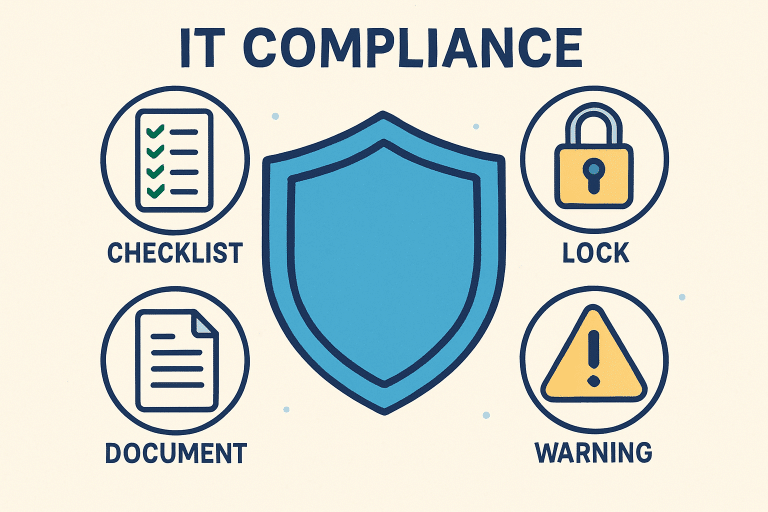Key Takeaways
- Conduct regular risk assessments to stay alert to emerging issues.
- Update and monitor compliance processes to address ongoing regulatory changes.
- Prioritize continuous training for all employees, tailored to their roles.
- Limit access to sensitive data by following the principle of least privilege.
- Establish an actionable incident response plan for effective breach management.
IT compliance is crucial for organizations aiming to safeguard sensitive data, establish customer trust, and mitigate the risk of regulatory penalties. However, navigating compliance requirements is far from straightforward, and businesses frequently encounter mistakes that threaten their security posture. Understanding these issues and knowing how to avoid them is crucial for building a resilient and compliant IT environment. For an in-depth overview of core compliance requirements, read more about IT compliance basics to ground your strategy on the essentials.
From neglecting risk assessments to insufficient staff training, the pitfalls are many and often costly. Organizations must take a proactive approach, embracing best practices in compliance management to maintain operational integrity and customer confidence.
Neglecting Regular Risk Assessments
Companies often neglect periodic risk assessments, which can lead to undetected vulnerabilities that may result in significant issues. Regulatory frameworks like GDPR and HIPAA emphasize the importance of regular evaluations to identify risks and strengthen controls, as skipping these checks can result in data breaches, penalties, and reputational damage. To mitigate this risk, organizations should establish a formal process for annual risk assessments or following major system upgrades. They should also collaborate with IT professionals or auditors to evaluate security controls and utilize established frameworks, such as NIST or ISO 27001, to enhance assessment effectiveness and audit preparedness.
Treating Compliance as a One-Time Task
Managed IT Services play a pivotal role in strengthening compliance, which should not be viewed merely as a checklist for annual reviews, as this mindset hinders an organization’s ability to adapt to regulatory changes and security threats. Instead, it is a dynamic process requiring evolving policies, technologies, and practices. To foster continuous compliance, organizations should conduct regular audits and use automated monitoring systems to track risks and adherence to policies. Prompt updates to internal frameworks in response to new regulations ensure readiness for inspections and promote a proactive mindset among employees.
Inadequate Employee Training
Employees are crucial in defending against cyber threats and non-compliance, but inadequate training creates vulnerabilities. To mitigate these risks, organizations should provide regular, department-specific training on password safety, privacy, and recognizing suspicious activities. Keeping updated records of training completion is essential for compliance, and ongoing engagement can be achieved through practical exercises and phishing simulations.
Weak Access Controls
Granting excessive access can lead to unauthorized disclosure of sensitive data. Organizations often neglect to update permissions when roles change or employees leave, thereby increasing risks and exposing sensitive data. To prevent this, apply the principle of least privilege by restricting access to only those who need it. Regularly review permissions and revoke outdated access, automating the process for consistency and accuracy.
Lack of Incident Response Planning
Organizations without a tested incident response plan often experience confusion and delays during breaches, resulting in higher recovery costs and increased regulatory penalties. To avoid this, develop a detailed plan that outlines team roles, communication protocols, and procedures for investigation, containment, and recovery. Regular testing and refinement of the plan through simulated exercises, along with updates based on lessons learned, are essential.
Overlooking Third-Party Vendor Risks
Supply chain vulnerabilities pose compliance risks, as organizations frequently overlook the verification of vendor security controls, which can lead to potential data breaches. To mitigate this risk, implement a strong vendor management process that includes due diligence before onboarding, contractual compliance commitments, regular audits, and ongoing monitoring of third-party adherence to established security standards.
Delaying Security Patches and Updates
Outdated software poses security risks and compliance issues due to unpatched vulnerabilities. To mitigate these risks, organizations should establish automated processes for managing software updates, use centralized systems for compliance monitoring, and prioritize these measures in IT governance policies for enhanced security resilience.
Poor Documentation Practices
Lack of organized documentation significantly impedes compliance efforts and audit readiness, making it challenging to demonstrate adherence to regulations. To overcome this, organizations should invest in documentation tools that automate record-keeping and ensure detailed records of policy updates, training sessions, and incident responses. This proactive approach enhances regulatory reporting, strengthens compliance programs, safeguards sensitive data, and cultivates trust with clients and regulators.
Conclusion
Effective compliance is not achieved through isolated measures but through a comprehensive, proactive strategy that addresses risks across people, processes, and technology. By conducting regular risk assessments, strengthening access controls, implementing continuous training, and overseeing vendors, each element works together to minimize vulnerabilities. Leveraging solutions can further streamline compliance by providing expert support, automation, and monitoring, ensuring organizations remain resilient against evolving threats. By embedding compliance into daily operations, businesses not only avoid penalties but also build long-term trust, security, and sustainability.
